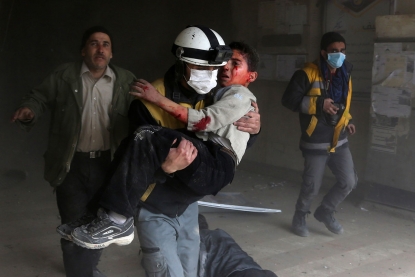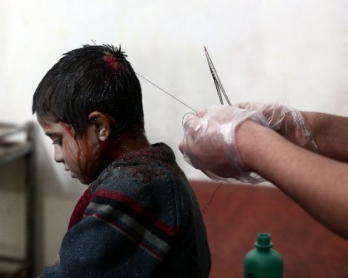Life so full of blood
Eastern Ghouta, Syria -- Life has become so scary and so full of blood. Before, the shelling was concentrated in the areas where rebels and the government troops were clashing. But now, any place can be a target, day or night.
 Air strike in Eastern Ghouta, February 8, 2018. (AFP / Abdulmonam Eassa)
Air strike in Eastern Ghouta, February 8, 2018. (AFP / Abdulmonam Eassa) Aftermath of an air strik, Eastern Ghouta, February 8, 2018. (AFP / Abdulmonam Eassa)
Aftermath of an air strik, Eastern Ghouta, February 8, 2018. (AFP / Abdulmonam Eassa)
Eastern Ghouta, where I live, is the last area held by rebels on the doorstep of the Syrian capital Damascus. It’s a collection of towns home to around 400,000 people. But last week you would have never suspected as much -- the streets were deserted. Last week Syrian government forces unleashed an intense five-day campaign of air strike and artillery fire that killed some 250 civilians. Three times that were wounded.
 A member of the Syrian civil defence carries a wounded child from the rubble after a reported regime air strike in the rebel-held town of Jisreen, in the besieged Eastern Ghouta region on the outskirts of the capital Damascus, on February 8, 2018. (AFP / Abdulmonam Eassa)
A member of the Syrian civil defence carries a wounded child from the rubble after a reported regime air strike in the rebel-held town of Jisreen, in the besieged Eastern Ghouta region on the outskirts of the capital Damascus, on February 8, 2018. (AFP / Abdulmonam Eassa)The roads completely emptied of women and children; there were just men in the streets. People resorted to sitting in the ground floors or basements of their buildings and schools. But the bombardments were so strong that sometimes even people cowering in cellars were killed or wounded.
 After the air strike, Eastern Ghouta, February 8, 2018.
(AFP / Abdulmonam Eassa)
After the air strike, Eastern Ghouta, February 8, 2018.
(AFP / Abdulmonam Eassa)During the day, you could see some men in the streets, usually keeping close to the entrance of their houses. When the sound of an airplane pierced the air, everyone ran for shelter. But no place was truly safe -- the shelling targeted mosques, houses, schools, markets, main roads, even basements.
 A member of the Syrian civil defence carries the body of a child out of the rubble of a house that was hit by a reported regime air strike in the rebel-held town of Jisreen, in the besieged Eastern Ghouta region on the outskirts of the capital Damascus on February 8, 2018. (AFP / Abdulmonam Eassa)
A member of the Syrian civil defence carries the body of a child out of the rubble of a house that was hit by a reported regime air strike in the rebel-held town of Jisreen, in the besieged Eastern Ghouta region on the outskirts of the capital Damascus on February 8, 2018. (AFP / Abdulmonam Eassa)How do you live in a situation like that? You adapt. Although markets emptied and most stores were shuttered, some remained open all day. Some people just got used to the shelling, it’s as if they were waiting for death in the streets.
The shelling was so omnipresent that people buried their dead as quickly as possible -- for fear that the cemetery would be targeted while they were there. Sometimes the dead would be buried at night.
Fear grips you often when you live through something like this, but you learn to deal with it. One day I was with some paramedics and rescuers, taking pictures, when an aircraft returned to target the same place with a missile. We were about 100 meters away. After the strike, we went into an old house, to take out two children and a woman from under the rubble. Just then, an artillery bombardment struck the area, sending everyone fleeing except for the rescuers and me. I could feel the fear creeping over me, but I realized that it won’t change anything to be scared. So I took my pictures and left as quickly as I could.
Goods have become scarce and prices for them have skyrocketed. Main meals consist of mostly rice or bulgur; breakfast is some olives and yogurt. Electricity is available for only about five hours per day and is very expensive. I need electricity for my work, so I have no choice but to use it. I pay about 100 US dollars per month -- that buys me just enough to send my pictures and charge the batteries for my cameras.
One day, I went out of the house without eating, as often the case. Three times I ended up photographing carnage that day, the bloody aftermath of air strikes. When I returned to the house, I couldn’t eat anything. I was too tired and too shaken by what I had seen. Tears were streaming down my face. I sent my pictures and went straight to bed. The next morning I woke to the sound of airplanes.
Graphic content
 Bodies of children killed in a reported regime air strike in the rebel-held town of Hamouria, in the besieged Eastern Ghouta region on the outskirts of the capital Damascus on February 7, 2018. (AFP / Abdulmonam Eassa)
Bodies of children killed in a reported regime air strike in the rebel-held town of Hamouria, in the besieged Eastern Ghouta region on the outskirts of the capital Damascus on February 7, 2018. (AFP / Abdulmonam Eassa)
As a photographer, you see more than most people, because you seek out the places of death. But everyone here has been touched by it. The people of Ghouta have been forgotten and I just hope that my images will serve as a reminder of the bloodshed that is happening here.
This blog was written with Samar Hazboun in Nicosia and Yana Dlugy in Paris.






